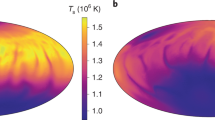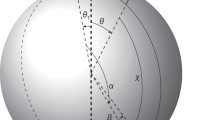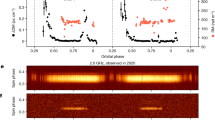Abstract
The discovery of a second millisecond binary radio pulsar1, PSR1855+09 (period P = 5ms), with a relatively wide circular orbit and low mass function indicates that the incidence of such systems (see also refs 2, 3) among the galactic radio pulsar population is ∼4 × 10−3. The generally accepted model for the origin of these systems is that they have descended from low-mass X-ray binaries in which a weakly magnetized neutron star3 was spun-up by the accretion of matter from an evolved low-mass (⩽1.2 M⊙) companion star, which has now ended its life as a helium white dwarf3–8. We show here that, based on the incidence of the progenitor low-mass X-ray binaries (LMXBs), the observed incidence of millisecond binary radio pulsars can be explained only if, at their present low field strength of ∼109G, the decay timescale of neutron-star surface magnetic dipole moments is 322153a0109 yr. This possibility has been advanced by Kulkarni9, who estimates, based on the optical detection of the counterpart of the weak-field binary radio pulsar PSR0655 + 64, that this pulsar is old (>5 × 108 yr) and hence that the magnetic field decay timescale becomes very large (>109 yr) for field strengths ≲1010 G. Our findings provide independent support for this possibility.
This is a preview of subscription content, access via your institution
Access options
Subscribe to this journal
Receive 51 print issues and online access
$199.00 per year
only $3.90 per issue
Buy this article
- Purchase on Springer Link
- Instant access to full article PDF
Prices may be subject to local taxes which are calculated during checkout
Similar content being viewed by others
References
Segelstein, D. J., Taylor, J. H., Rawley, I. A. & Stinebring, D. R. IAU Circ. No. 4162 (1986).
Boriakoff, V., Buccheri, R. & Fauci, F. Nature 304, 417–419 (1983).
Rawley, L. A., Taylor, J. H. & Davis, M. M. Nature 319, 383–384 (1986).
Savonije, G. J. Nature 304, 422–423 (1983).
Paczynski, B. Nature 304, 421–422 (1983).
Joss, P. C. & Rappaport, S. A. Nature 304, 419–421 (1983).
Van den Heuvel, E. P. J. & Taam, R. E. Nature 309, 235–237 (1984).
Van den Heuvel, E. P. J. J. Astrophys. Astr. 5, 209–233 (1984).
Kulkarni, S. R. Astrophys. J. (in the press).
Webbink, R. F., Rappaport, S. A. & Savonije, G. J. Astrophys. J. 270, 678–693 (1983).
Bradt, H. L. V. & McClintock, J. E. A. Rev. Astr. Astrophys. 21, 13–66 (1983).
Sutantyo, W. & Van den Heuvel, E. P. J. in The Evolution of Galactic X-ray Binaries (eds Truemper, J., Lewin, W. H. G. & Binkmann, W.) 183–187 (Reidel, Dordrecht, 1986).
Taam, R. E. & Van den Heuvel, E. P. J. Astrophys. J. 305 (in the press) (1986).
Lyne, A. G., Manchester, R. N. & Taylor, J. H. Mon. Not. R. astr. Soc. 213, 613–639 (1985).
Hut, P. & Verbunt, F. in Cataclysmic Variables and Low-Mass X-ray Binaries (eds Lamb, D. Q. & Patterson, J. 103–106 (Reidel, Dordrecht, 1983).
Krolik, J. H., Meiksin, A. & Joss, P. C. Astrophys. J. 282, 466–480 (1984).
Hut, P. & Paczynski, B. Astrophys. J. 284, 675–684 (1984).
Alpar, M. A., Cheng, A. F., Ruderman, M. A. & Shaham, J. Nature 300, 728–730 (1982).
Weisberg, J. M. & Taylor, J. H. Phys. Rev. Lett. 52, 1348–1350 (1984).
Jeffrey, L. C. Nature 319, 384–386 (1986).
Van den Heuvel, E. P. J. & Bonsema, P. F. J. Astr. Astrophys. 139, L16–L17 (1985).
Flowers, E. & Ruderman, M. A. Astrophys. J. 215, 302–310 (1977).
Harvey, J., Ruderman, M. A. & Shaham, J. Phys. Rev. D (in the press).
Muslimov, A. G. & Tsygan, A. I. Sov. Astr. Lett. 11, 80–83 (1985).
Kundt, W. Astr. Astropys. 98, 207–210 (1981).
Dewey, R. J., Maguire, C. M., Rawley, L. A., Stokes, G. H. & Taylor, J. H. Nature (in the press).
Bhattacharya, D. & Srinivasan, G. Curr. Sci. 55, 327–330 (1986).
Author information
Authors and Affiliations
Rights and permissions
About this article
Cite this article
van den Heuvel, E., van Paradijs, J. & Taam, R. Evidence for an asymptotic lower limit to the surface dipole magnetic field strengths of neutron stars. Nature 322, 153–155 (1986). https://doi.org/10.1038/322153a0
Received:
Accepted:
Issue Date:
DOI: https://doi.org/10.1038/322153a0
This article is cited by
-
Thin accretion disc with a corona in a central magnetic field
Astrophysics and Space Science (2008)
-
Gamma rays from millisecond pulsars
Journal of Astrophysics and Astronomy (1991)
Comments
By submitting a comment you agree to abide by our Terms and Community Guidelines. If you find something abusive or that does not comply with our terms or guidelines please flag it as inappropriate.



